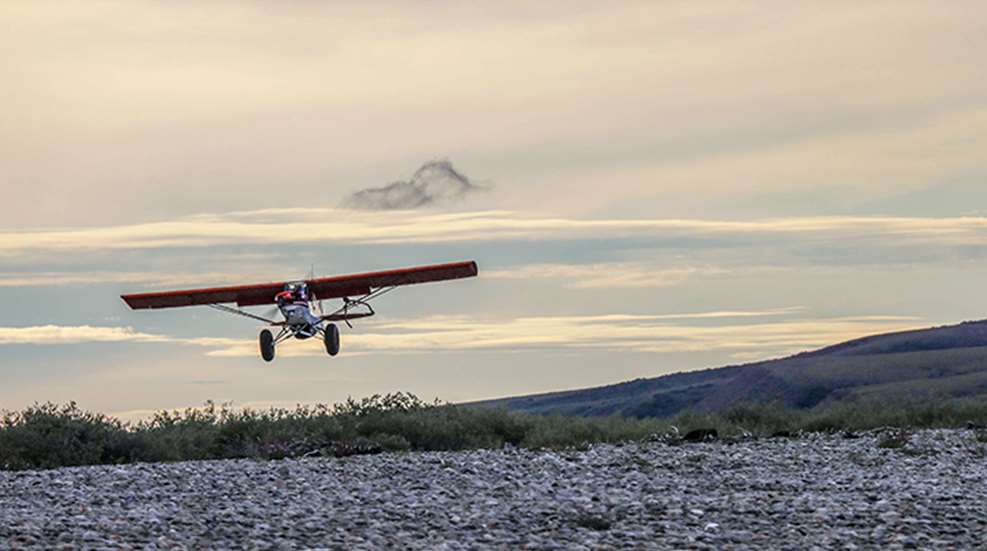
Each autumn the Western Arctic caribou herd leaves their calving grounds in the northwestern Alaska and moves south and east in search of better pasture. The journey leads the animals through the Brooks Range and covers more than 2,700 miles, making it the longest terrestrial migration on Earth. Since the first caribou crossed the Bering Land Bridge from Asia 20,000 years ago, these animals have been pursued by predators of all types including wolves, grizzly bears and the first humans to inhabit North America. Chances are the first person to set foot on this continent was a caribou hunter.
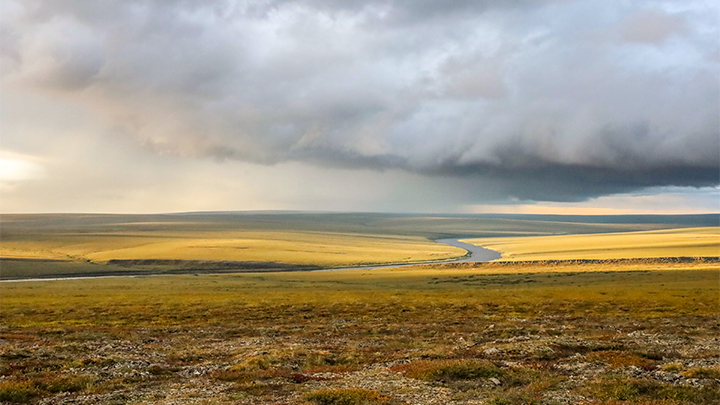
It was a privilege when I was invited to accompany a group from Hornady, Leupold and Savage Arms into Alaska in search of the Western Arctic caribou herd. Though the distance these caribou travel during their migration is vast (roughly the equivalent of walking from Los Angeles to New York City), the portion of the state through which the herd travels is so remote that only a handful of human eyes witness the great migration. I was happy to be one of the few to witness it firsthand.
■ ■ ■
Our hunting party was scheduled to fly from Fairbanks to a remote airstrip deep in the Arctic, but low clouds and unsettled weather kept our charter flight grounded for more than 24 hours. Eventually conditions improved and our airplane touched down on the fractured tarmac of an old petroleum exploration airstrip an hour south of the Arctic Ocean. Besides the outfitter’s camp, the only buildings were two Quonset huts and a dilapidated control tower with a ragged, sun-bleached windsock.
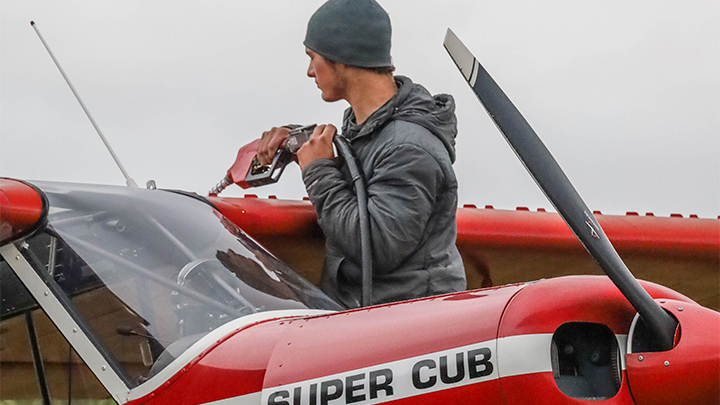
From this remote port we were to head 130 river miles to our base camp in an inflatable Russian raft powered by a 35-hp Tohatsu motor—a 10-hour, one-way ride that carried us into one of the most isolated parts of the North Slope. Between the airstrip and base camp, which consisted of four dome tents spread on a gravel bar in some nameless stretch of gray water, we didn’t see a sign of human life throughout the journey.
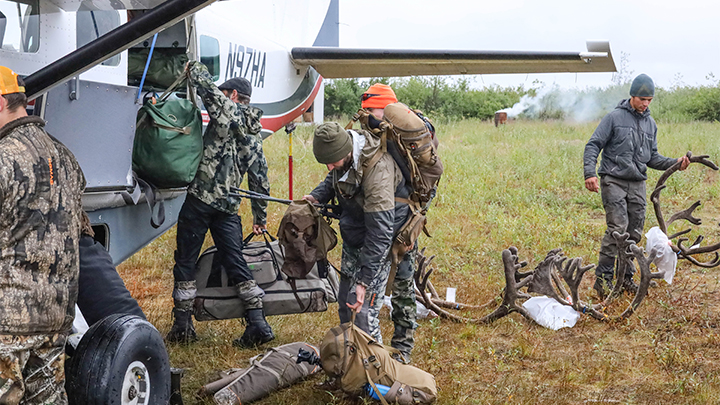
Our outfitter was Striker Overly, whose family has been hunting professionally in Alaska for decades. Only an outfitter with such a long history in the hunting business could overcome the logistical hurdles involved with transporting hunters so deep into the Artic. We were counting on Overly to do more than just drop us in an area where we might intercept passing caribou—without his help we wouldn’t be able to escape the Arctic. By the time we settled into the tents, wet and ragged after the long boat ride, the light had faded to copper-red and the only sound was the bubbling of cold water rushing over rocks in the river.
■ ■ ■
The high latitudes of the Arctic mean round-the-clock sunlight during late summer. The lack of defined days and nights made the separation from the outside world more intense. I found myself glassing for game at 2 o’clock in the morning and sleeping soundly by noon. The mosquitoes were the only thing that remained constant. Head nets and bug spray were part of the Arctic hunting uniform, and it wasn’t uncommon to see bedded or feeding caribou burst suddenly into a full run over the tussocks in an effort to free themselves from the black hordes of insects. Periods of heavy wind that sent the mosquitoes into hiding were the only respite for man or beast.
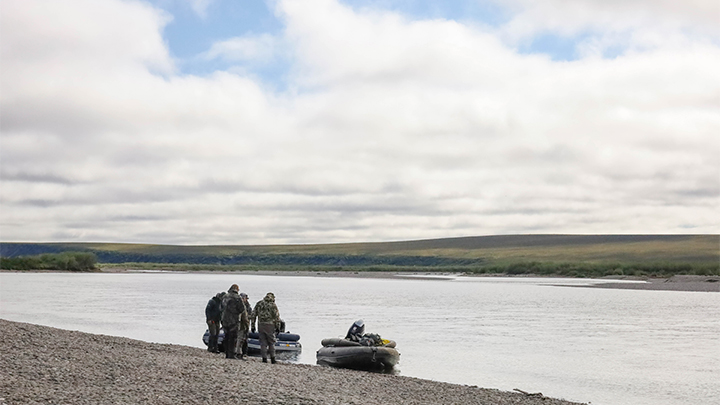
Compared to traditional camps, which run on a strict schedule, hunting caribou in the Arctic was a relaxed affair. Using rafts, we’d travel up- or downstream from our main camp and head up backwater eddies with nicknames like Rockslide, Horseshoe and Long Beach. Our party, which consisted of guides Geordy and Randy, Guns & Ammo’s Tom Beckstrand, Neal Emery from Hornady and Shawn Skipper from Leupold, would run over the shallow rivers (you could often see, in disturbing detail, the features of the fist-sized rocks just below the surface) in the jet-powered rafts until we found a bluff or hill that offered a good view of the surrounding tundra. From there, we spent hours glassing. Sometimes our party split up to cover more ground. For hours we sat on the slopes, eating fresh blueberries, soaking in the summer sun between rainstorms and waiting for caribou.
The migration doesn’t run on a set schedule, though. We were ahead of the largest herds and settled for glassing singles or pairs that were either resident caribou or the first migrants from the far north. Neal Emery found just such a caribou, a bull with an unbelievable 19-inch shovel that stood alone on a gravel bar alongside the river. Neal got into position and made a difficult shot, and when the 6.5 PRC Hornady bullet from his Savage 110 Ultralite rifle struck the bull it dropped immediately. That made for fast and easy butchering and packing out, and a strong breeze even kept the mosquitoes at bay.
■ ■ ■
My own hunt wasn’t nearly as simple. We spotted a bull from a high ridge overlooking one of the creeks where we’d tied our raft. The bull was on the opposite ridge across a wide glacial valley.
“I think you may want to look at this bull,” Geordy said to me. I leaned over his spotting scope and saw the bull’s wide, tall headgear. I wasn’t sure if it was the poor light (long streams of rain were falling from the clouds all around us), but the bull’s antlers appeared more gray than brown.
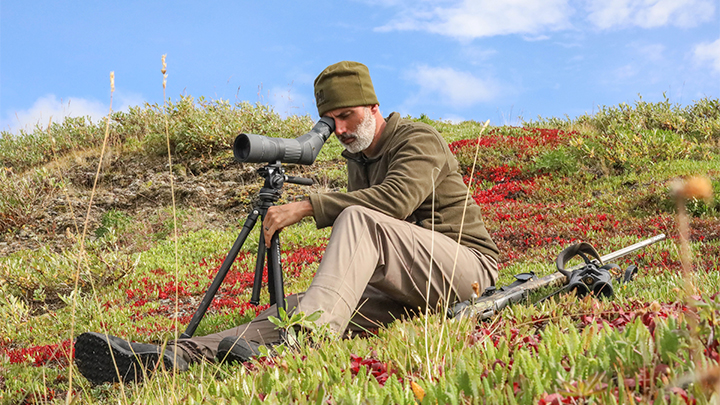
“He looks good to me,” I said. Caribou are notoriously difficult for new hunters to evaluate because all the bulls look big. I asked Geordy what he thought and he told me he thought the bull was worth the effort.
“Are you up for a death march?” he asked. I nodded, and he stared at me for a moment.
“Are you sure?”
“Yes,” I said and began rearranging the contents of my pack. I had my Savage 110 Ultralite in .280 Ackley Improved. Both the magazine in the rifle and the spare mag were loaded with Hornady’s 150-grain GMX bullets, and I had a spare box in the pack along with my water filter bottle, skinning knife and Leupold Santiam binocular. The spotting scope would stay behind along with all the provisions to make spike camp, and that lightened the load enough that I was sure we could cover the distance in a relatively short amount of time. Shawn Skipper shot the range to the peak with his Leupold RX-2800 TBR/W rangefinder. “It’s 2,000 yards as the crow flies,” he said.
Geordy and I crossed the river and tied the boat then began using the terrain as cover as we stalked the bull. A small ridge ran along the side of the mountain where the caribou was standing, and that provided just enough cover to conceal our approach. Aside from some scrub willows along the river there wasn’t a plant taller than my waist anywhere in this corner of the Arctic.
It was after 9 o’clock at night and the mix of storms and sun covered the hill in shadows and dim orange light. I failed to account for the fact that the mile-plus hike was over a field of tussocks, or muskeg. For those unfamiliar with muskeg, it’s comprised of rounded tufts of vegetation that form elevated knobs surrounded by moats of swampy, low mud. The effect is walking over a field of basketballs covered with a blanket. I alternated between stepping on the tops of the muskeg, which was a bad idea, and trying to walk around the swampy base of the stuff, which proved to be even worse.
“What’s the right way to walk on this stuff?” I asked Geordy. I’d crossed muskeg before, but never for such a long stretch and certainly never in a hurry.
“There isn’t a right way,” he said matter-of-factly. He was right.
On sore ankles and stumbling like a drunk, I made it to the shelf halfway up the ridge. Geordy peeked over the edge to look for the caribou. I shed my rain gear, but it was too late: the half-mile walk over uneven ground had soaked my base and mid layers.
We couldn’t see the bull from our position so we moved higher, picking our way more carefully now, eventually reaching a layer of shelf rock near the top of the hill and escaping the muskeg, much to my relief. But the bull was gone.
If the caribou had spooked and crested the grassy hilltop he might be 2 miles ahead of us by now, and I’d spent quite enough time tripping over the muskeg for one day. I hated to miss an opportunity at a good bull, though, and I couldn’t imagine we’d been spotted. Geordy agreed. He moved up to the ridge top and suddenly turned and dropped, motioning for me to follow.
“Bull’s up there,” he said when I caught him. “He went to the left.”
We climbed the ridge and knelt at the crest. I could see the bull’s great antlers just over the horizon. He’d dropped into a narrow valley that we couldn’t see from our earlier position. He was on the opposite hill by then, feeding in the open and just about to cross the next small peak.
“Can you make the shot?”
I told Geordy I could and asked him to call the range. He said the bull was 290 yards, and when the Savage was set on my pack I chambered a round and rotated the Leupold’s CDS dial to the appropriate distance.
“He’s just about to clear the ridge,” Geordy said. “Can you see his vitals?”
With the VX-5HD cranked to 15X, I could clearly see the seam on the bull’s front leg. Everything above his knees was visible.
“Yes,” I said. “I’ve got a clear shot.”
“Well, take him, if you can.”
The illuminated center dot came to rest on the bull’s shoulder and I squeezed the trigger. It seemed an eternity between the time the rifle cracked and the resounding thwop of the bullet strike, but through the reticle I saw the bull drop straight down. We had him.
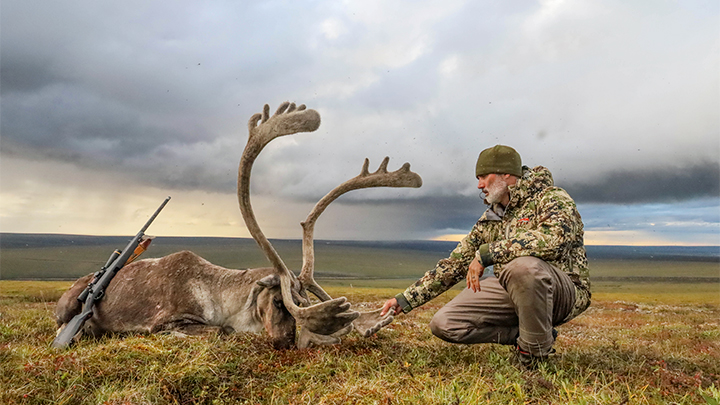
Geordy and I made our way to the place where the bull went down, and he was magnificent. The odd tint of his velvet we’d noticed in the spotting scope wasn’t imagined: the bull had unique silver fur on his massive antlers, something neither Geordy nor I had ever seen. We shook hands and took photos, and then began the butchering process. Sheets of rain continued to fall all around, and here and there the sun would peek through the clouds and a cascade of gold light would illuminate a patch of tundra. When all of the meat was removed, we filled our packs and I hoisted the antlers onto my back. Geordy led the way, and I followed him down the mountain to the boat, promising that if I made it down the muskeg mountain without breaking an ankle or giving out that I’d never skip a day at the gym again so long as I lived.
■ ■ ■
Neal and Shawn awaited us on the opposite side of the river, where they’d sat through the five-and-a-half-hour operation. We loaded the bull into the boat and I sat in the middle seat, filling my Survivor Filter over the side of the raft.
“What time is it?” I asked.
“Two-thirty,” Geordy said. “We still have two hours back to camp.”
We reached base sometime after 5, but I remember very little of the ride. Not long after we loaded the caribou I fell asleep with my head on my bloodstained pack, exhausted.
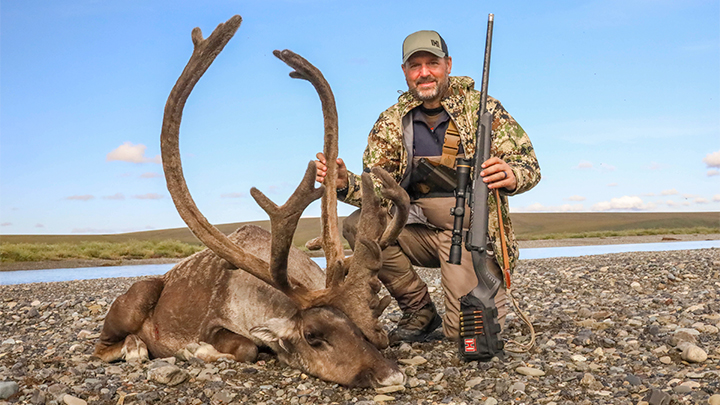
The Arctic is a tough land, and hunting there makes one appreciate both our primitive ancestors who crossed this uncharted tundra but also the caribou themselves. To survive the Arctic’s sudden changes in weather, sparse forage, abundant predators and relentless insects is no mean feat. But the caribou continue to thrive here, traveling thousands of miles across this tundra that looks very much like it did in ages past. Seeing the spectacle in person is one of the greatest experiences of my hunting career.




































